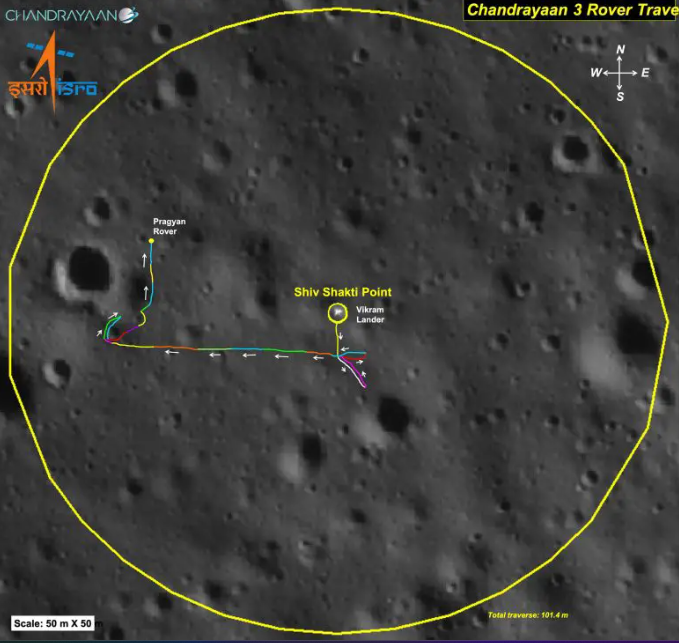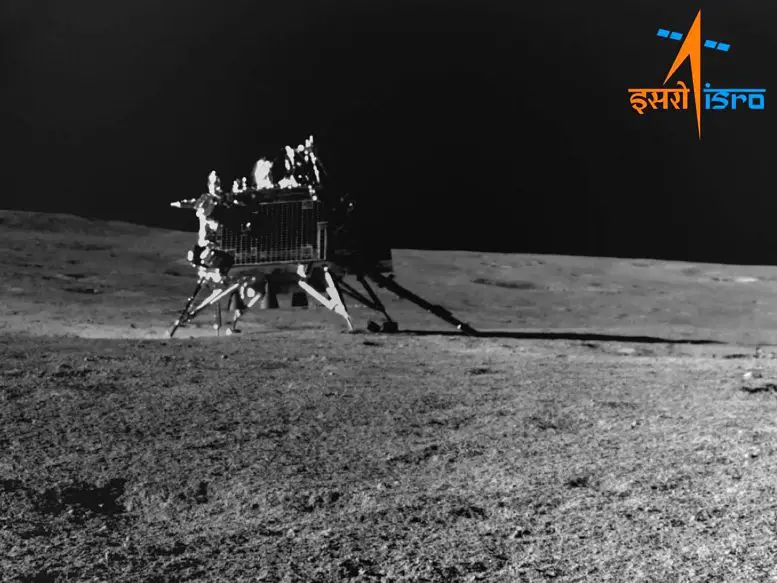The severe temperatures of the lunar night are probably to blame for ISRO’s Chandrayaan-3’s loss of communication after landing on the Moon’s south pole. A sliver of optimism for reactivation can be found in comparisons to China’s successful Chang’e 4 mission.
Chandrayaan-3, an Indian spacecraft, appears to have succumbed to the cold and its mission is done. A new day has begun after a brief two-week period of the bitter lunar night. Hopes for the lander and rover to awaken in the daylight on that day were raised, but the India Space Research Organisation (ISRO) believes those odds are dwindling by the hour.
End of the Lunar Night and a Silent Dawn:Chandrayaan-3
The current lunar day will last 14 days, just like the lunar night that encircled the lander and rover did. Last Friday morning, ISRO started attempting to contact the lander. No response has been received to date, and both explorers may be permanently buried approximately 600 kilometres (373 miles) from the south pole of the moon.
Even if the mission’s prospects don’t seem promising, it was nevertheless successful. It is the first spacecraft to touch down near the south pole of the Moon. The location is crucial because its continuously shadowed crater holds enormous amounts of frozen water. For astronauts who visit and establish bases on the Moon in the future, that water will be a vital resource. Additionally, since Chandrayaan-2’s predecessor crashed into the Moon’s surface, this is the first time that ISRO has successfully landed a lander and rover on the lunar surface.

Chandrayaan-3’s Features and Design
But the fact that Vikram and Pragyaan are still together is positive. After putting them into sleep mode as night fell, ISRO believed that the Sun would awaken both. It’s possible that the sunlight will allow the batteries to recharge.
At the start of the new lunar day on Friday, ISRO issued an update. Unfortunately, neither the lander nor the rover made any noise.
Temperature Challenges and Design Limitations
Temperatures at the Moon’s south pole during the night can drop as low as -200°C to -250°C (-328°F to -418°F). The lander and rover were not intended to operate in these conditions. The solar array may be deployed by the rover’s battery, which is only 10 amp-hours in size. Additionally, it was included to help the rover endure recurring eclipses. The solar panels were set up to receive incoming starlight when dawn arrived, and the tiny battery was fully charged when night fell. Also prepared for the morning was the Vikram lander, which had a fully charged 62.5 amp hour.
Both cars are set up to restart as soon as the Sun appears. According to M Srikanth, Chandrayaan-3 Mission Operations Director, “when sunlight comes back, there is an autonomous logic pre-loaded on both the lander and rover.” If they have survived the night and there is enough sun output, they are anticipated to reanimate.

SOURCE:If ISRO’s Chandrayaan-3 mission is truly over, it was still a success. It was the first spacecraft to land at the Moon’s south pole region. Credit: ISRO
Isro chief AS Kiran Kumar, however, asserts that the “chances of reawakening are dimming with each passing hour.” Kumar further stated in an interview with the BBC that “The lander and rover have so many components which may not have survived the frigid temperatures on the Moon.” Fair enough, they were never intended to.
Now, everything depends on the lander’s transmitter. It is the ISRO’s connection to the mission, therefore if it breaks down, it won’t matter even if some of the spacecraft’s other systems are still operational. It must reveal its existence to us. We have no means of knowing whether or not all other subsystems function,” Kumar continued.
Comparative Hope from Chang’e 4
Based in part on China’s successful Chang’e 4 mission, ISRO feels optimistic. It descended to the cold and darkness of the far side of the moon after landing there. It frequently awoke with the sunrise.
There’s still a tiny shred of hope, but it looks like Chandrayaan-3 is done.
ALSO READ:Astronaut Andreas Of The ESA Assumes Command Of The International Space Station In 2023




































